BMP3005 Applied Business Finance: Analyzing & Improving Performance
VerifiedAdded on 2023/06/18
|12
|2842
|431
Report
AI Summary
This report provides a comprehensive overview of financial management concepts and their importance in enhancing business performance. It defines financial management and discusses its key aspects, including long-term stability, budget estimation, decision-making, and profitability. The report details the main financial statements—profit and loss statement, statement of financial position, and cash flow statement—and explains the use of financial ratios in assessing solvency, risk, and overall financial health. A case study is used to illustrate the application of these concepts, with an analysis of profitability, liquidity, and efficiency ratios. The report concludes by discussing processes businesses can use to improve their financial performance, emphasizing the importance of wealth maximization and strategic planning. Desklib offers a range of resources, including past papers and solved assignments, to support students in their studies.

BSc (Hons) Business Management with
Foundation
BMP3005
Applied Business Finance
The concept and importance of financial
management and the processes
businesses might use to improve their
financial performance
1
Foundation
BMP3005
Applied Business Finance
The concept and importance of financial
management and the processes
businesses might use to improve their
financial performance
1
Paraphrase This Document
Need a fresh take? Get an instant paraphrase of this document with our AI Paraphraser
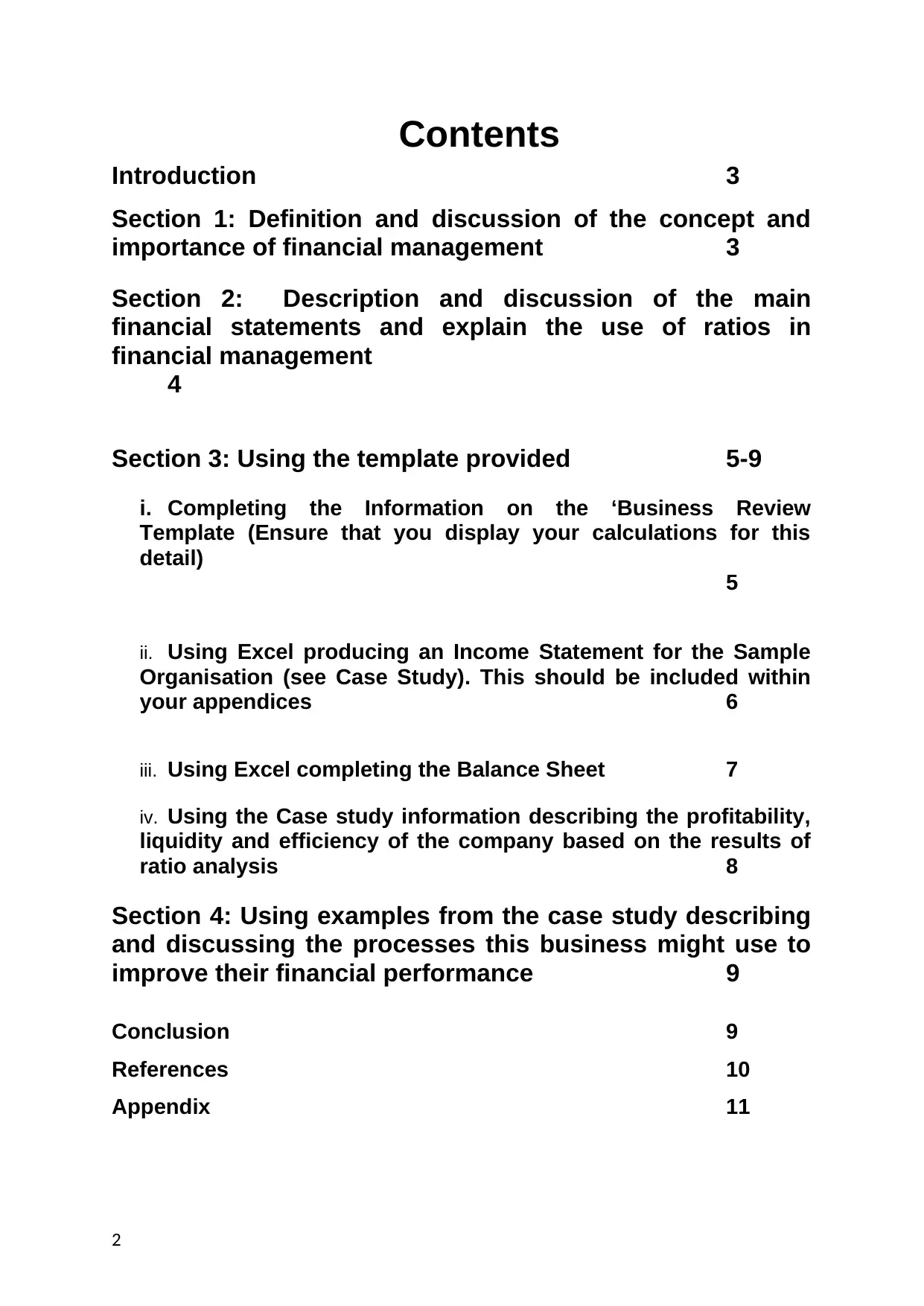
Contents
Introduction 3
Section 1: Definition and discussion of the concept and
importance of financial management 3
Section 2: Description and discussion of the main
financial statements and explain the use of ratios in
financial management
4
Section 3: Using the template provided 5-9
i. Completing the Information on the ‘Business Review
Template (Ensure that you display your calculations for this
detail)
5
ii. Using Excel producing an Income Statement for the Sample
Organisation (see Case Study). This should be included within
your appendices 6
iii. Using Excel completing the Balance Sheet 7
iv. Using the Case study information describing the profitability,
liquidity and efficiency of the company based on the results of
ratio analysis 8
Section 4: Using examples from the case study describing
and discussing the processes this business might use to
improve their financial performance 9
Conclusion 9
References 10
Appendix 11
2
Introduction 3
Section 1: Definition and discussion of the concept and
importance of financial management 3
Section 2: Description and discussion of the main
financial statements and explain the use of ratios in
financial management
4
Section 3: Using the template provided 5-9
i. Completing the Information on the ‘Business Review
Template (Ensure that you display your calculations for this
detail)
5
ii. Using Excel producing an Income Statement for the Sample
Organisation (see Case Study). This should be included within
your appendices 6
iii. Using Excel completing the Balance Sheet 7
iv. Using the Case study information describing the profitability,
liquidity and efficiency of the company based on the results of
ratio analysis 8
Section 4: Using examples from the case study describing
and discussing the processes this business might use to
improve their financial performance 9
Conclusion 9
References 10
Appendix 11
2
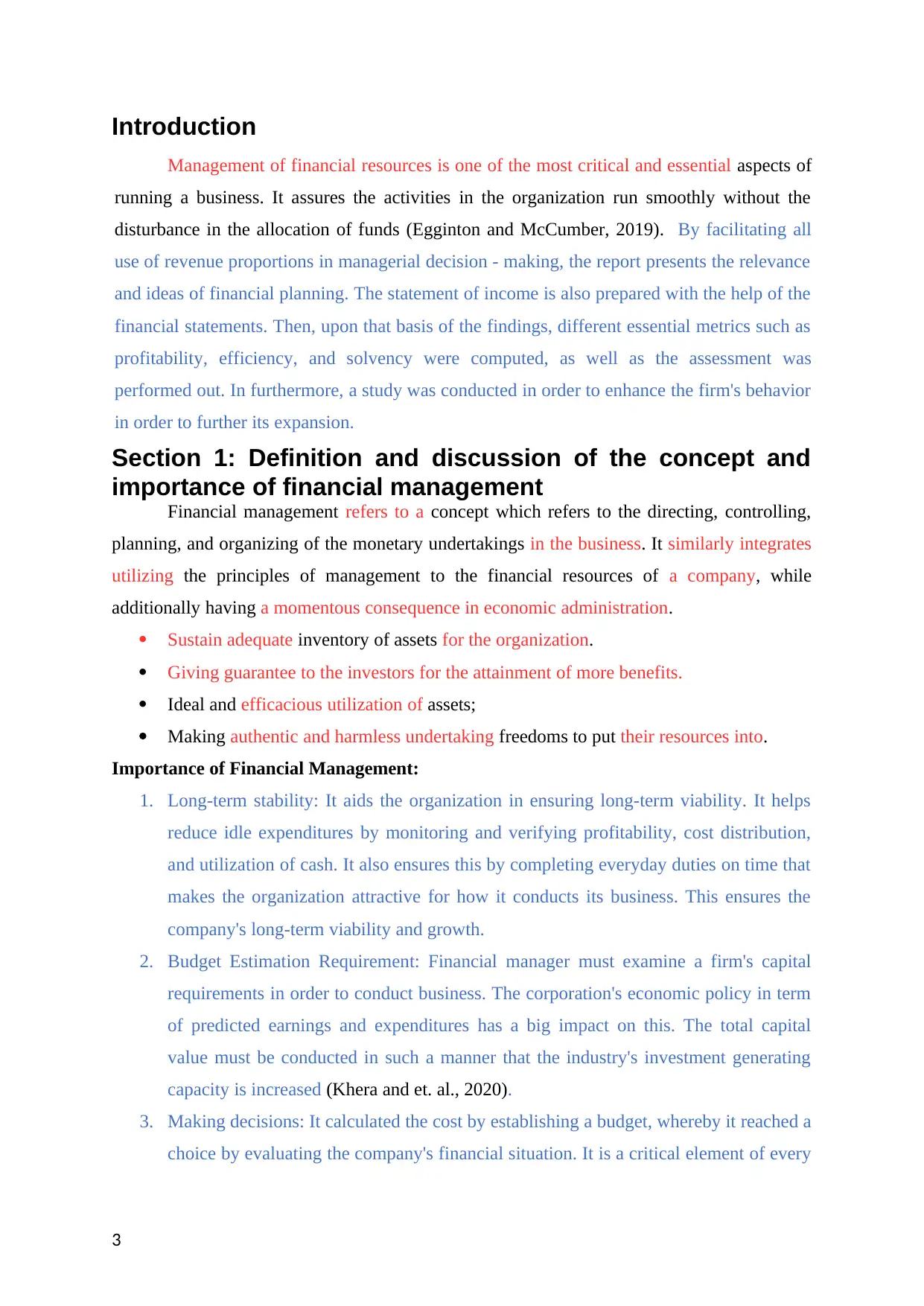
Introduction
Management of financial resources is one of the most critical and essential aspects of
running a business. It assures the activities in the organization run smoothly without the
disturbance in the allocation of funds (Egginton and McCumber, 2019). By facilitating all
use of revenue proportions in managerial decision - making, the report presents the relevance
and ideas of financial planning. The statement of income is also prepared with the help of the
financial statements. Then, upon that basis of the findings, different essential metrics such as
profitability, efficiency, and solvency were computed, as well as the assessment was
performed out. In furthermore, a study was conducted in order to enhance the firm's behavior
in order to further its expansion.
Section 1: Definition and discussion of the concept and
importance of financial management
Financial management refers to a concept which refers to the directing, controlling,
planning, and organizing of the monetary undertakings in the business. It similarly integrates
utilizing the principles of management to the financial resources of a company, while
additionally having a momentous consequence in economic administration.
Sustain adequate inventory of assets for the organization.
Giving guarantee to the investors for the attainment of more benefits.
Ideal and efficacious utilization of assets;
Making authentic and harmless undertaking freedoms to put their resources into.
Importance of Financial Management:
1. Long-term stability: It aids the organization in ensuring long-term viability. It helps
reduce idle expenditures by monitoring and verifying profitability, cost distribution,
and utilization of cash. It also ensures this by completing everyday duties on time that
makes the organization attractive for how it conducts its business. This ensures the
company's long-term viability and growth.
2. Budget Estimation Requirement: Financial manager must examine a firm's capital
requirements in order to conduct business. The corporation's economic policy in term
of predicted earnings and expenditures has a big impact on this. The total capital
value must be conducted in such a manner that the industry's investment generating
capacity is increased (Khera and et. al., 2020).
3. Making decisions: It calculated the cost by establishing a budget, whereby it reached a
choice by evaluating the company's financial situation. It is a critical element of every
3
Management of financial resources is one of the most critical and essential aspects of
running a business. It assures the activities in the organization run smoothly without the
disturbance in the allocation of funds (Egginton and McCumber, 2019). By facilitating all
use of revenue proportions in managerial decision - making, the report presents the relevance
and ideas of financial planning. The statement of income is also prepared with the help of the
financial statements. Then, upon that basis of the findings, different essential metrics such as
profitability, efficiency, and solvency were computed, as well as the assessment was
performed out. In furthermore, a study was conducted in order to enhance the firm's behavior
in order to further its expansion.
Section 1: Definition and discussion of the concept and
importance of financial management
Financial management refers to a concept which refers to the directing, controlling,
planning, and organizing of the monetary undertakings in the business. It similarly integrates
utilizing the principles of management to the financial resources of a company, while
additionally having a momentous consequence in economic administration.
Sustain adequate inventory of assets for the organization.
Giving guarantee to the investors for the attainment of more benefits.
Ideal and efficacious utilization of assets;
Making authentic and harmless undertaking freedoms to put their resources into.
Importance of Financial Management:
1. Long-term stability: It aids the organization in ensuring long-term viability. It helps
reduce idle expenditures by monitoring and verifying profitability, cost distribution,
and utilization of cash. It also ensures this by completing everyday duties on time that
makes the organization attractive for how it conducts its business. This ensures the
company's long-term viability and growth.
2. Budget Estimation Requirement: Financial manager must examine a firm's capital
requirements in order to conduct business. The corporation's economic policy in term
of predicted earnings and expenditures has a big impact on this. The total capital
value must be conducted in such a manner that the industry's investment generating
capacity is increased (Khera and et. al., 2020).
3. Making decisions: It calculated the cost by establishing a budget, whereby it reached a
choice by evaluating the company's financial situation. It is a critical element of every
3
⊘ This is a preview!⊘
Do you want full access?
Subscribe today to unlock all pages.

Trusted by 1+ million students worldwide
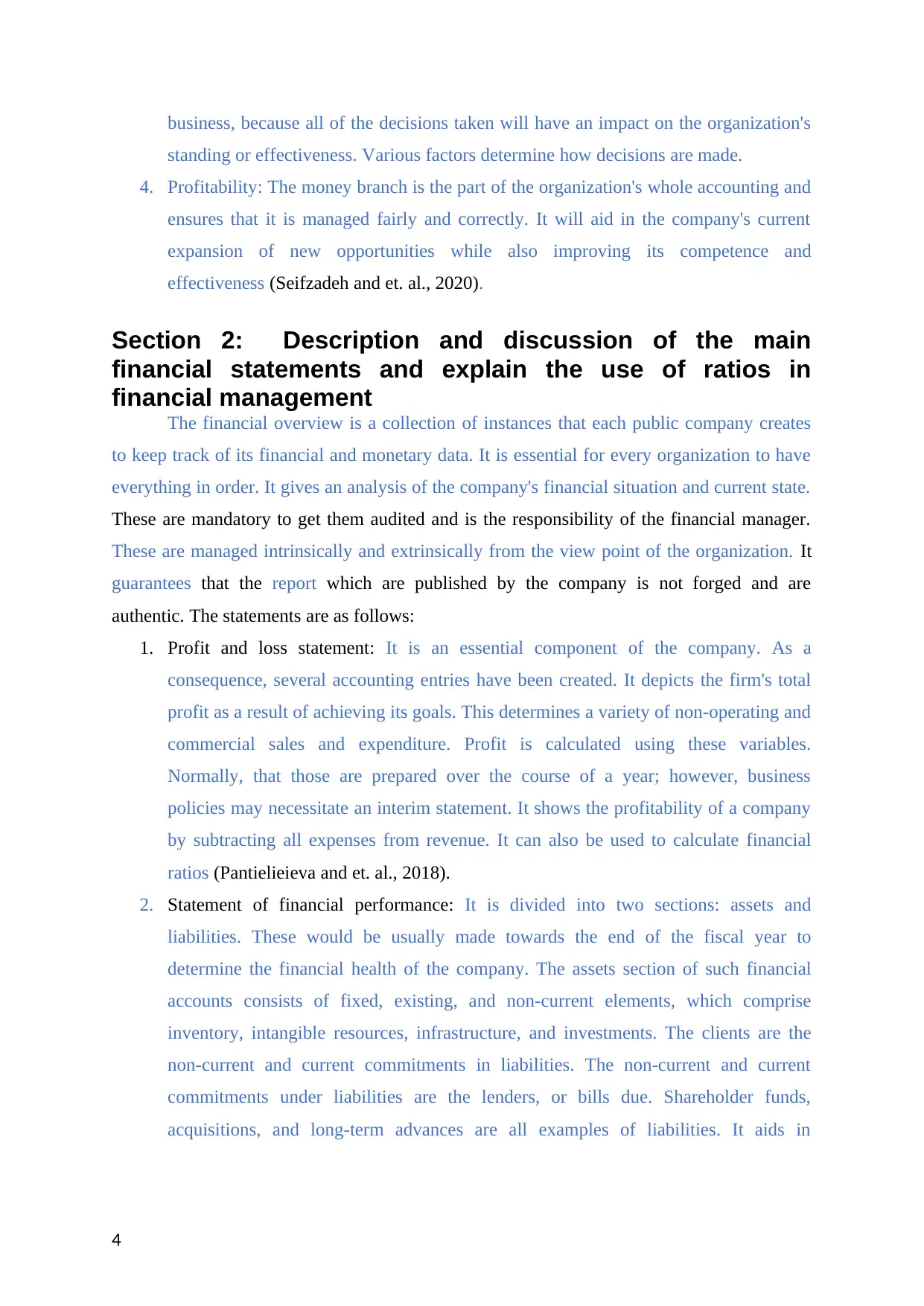
business, because all of the decisions taken will have an impact on the organization's
standing or effectiveness. Various factors determine how decisions are made.
4. Profitability: The money branch is the part of the organization's whole accounting and
ensures that it is managed fairly and correctly. It will aid in the company's current
expansion of new opportunities while also improving its competence and
effectiveness (Seifzadeh and et. al., 2020).
Section 2: Description and discussion of the main
financial statements and explain the use of ratios in
financial management
The financial overview is a collection of instances that each public company creates
to keep track of its financial and monetary data. It is essential for every organization to have
everything in order. It gives an analysis of the company's financial situation and current state.
These are mandatory to get them audited and is the responsibility of the financial manager.
These are managed intrinsically and extrinsically from the view point of the organization. It
guarantees that the report which are published by the company is not forged and are
authentic. The statements are as follows:
1. Profit and loss statement: It is an essential component of the company. As a
consequence, several accounting entries have been created. It depicts the firm's total
profit as a result of achieving its goals. This determines a variety of non-operating and
commercial sales and expenditure. Profit is calculated using these variables.
Normally, that those are prepared over the course of a year; however, business
policies may necessitate an interim statement. It shows the profitability of a company
by subtracting all expenses from revenue. It can also be used to calculate financial
ratios (Pantielieieva and et. al., 2018).
2. Statement of financial performance: It is divided into two sections: assets and
liabilities. These would be usually made towards the end of the fiscal year to
determine the financial health of the company. The assets section of such financial
accounts consists of fixed, existing, and non-current elements, which comprise
inventory, intangible resources, infrastructure, and investments. The clients are the
non-current and current commitments in liabilities. The non-current and current
commitments under liabilities are the lenders, or bills due. Shareholder funds,
acquisitions, and long-term advances are all examples of liabilities. It aids in
4
standing or effectiveness. Various factors determine how decisions are made.
4. Profitability: The money branch is the part of the organization's whole accounting and
ensures that it is managed fairly and correctly. It will aid in the company's current
expansion of new opportunities while also improving its competence and
effectiveness (Seifzadeh and et. al., 2020).
Section 2: Description and discussion of the main
financial statements and explain the use of ratios in
financial management
The financial overview is a collection of instances that each public company creates
to keep track of its financial and monetary data. It is essential for every organization to have
everything in order. It gives an analysis of the company's financial situation and current state.
These are mandatory to get them audited and is the responsibility of the financial manager.
These are managed intrinsically and extrinsically from the view point of the organization. It
guarantees that the report which are published by the company is not forged and are
authentic. The statements are as follows:
1. Profit and loss statement: It is an essential component of the company. As a
consequence, several accounting entries have been created. It depicts the firm's total
profit as a result of achieving its goals. This determines a variety of non-operating and
commercial sales and expenditure. Profit is calculated using these variables.
Normally, that those are prepared over the course of a year; however, business
policies may necessitate an interim statement. It shows the profitability of a company
by subtracting all expenses from revenue. It can also be used to calculate financial
ratios (Pantielieieva and et. al., 2018).
2. Statement of financial performance: It is divided into two sections: assets and
liabilities. These would be usually made towards the end of the fiscal year to
determine the financial health of the company. The assets section of such financial
accounts consists of fixed, existing, and non-current elements, which comprise
inventory, intangible resources, infrastructure, and investments. The clients are the
non-current and current commitments in liabilities. The non-current and current
commitments under liabilities are the lenders, or bills due. Shareholder funds,
acquisitions, and long-term advances are all examples of liabilities. It aids in
4
Paraphrase This Document
Need a fresh take? Get an instant paraphrase of this document with our AI Paraphraser
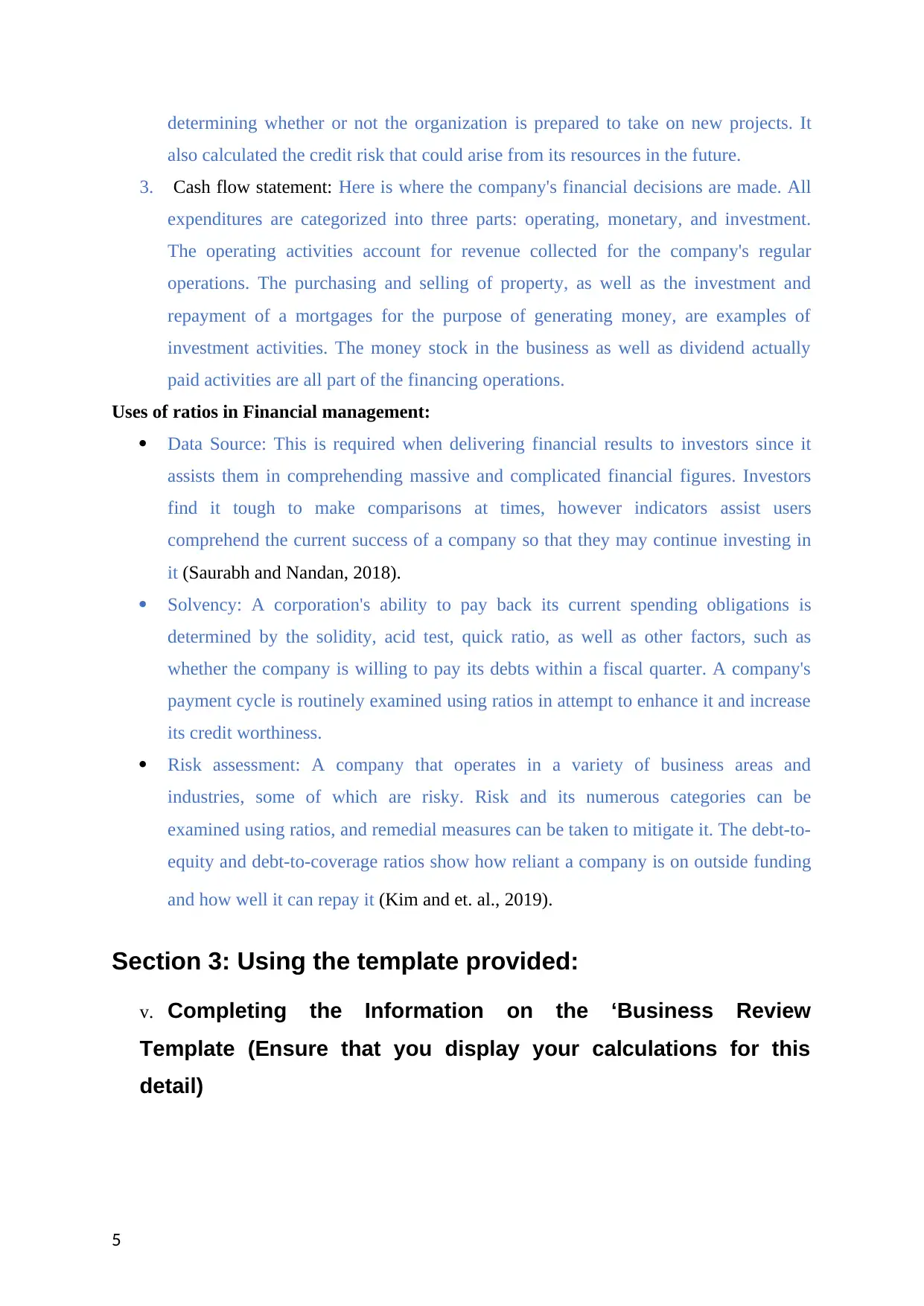
determining whether or not the organization is prepared to take on new projects. It
also calculated the credit risk that could arise from its resources in the future.
3. Cash flow statement: Here is where the company's financial decisions are made. All
expenditures are categorized into three parts: operating, monetary, and investment.
The operating activities account for revenue collected for the company's regular
operations. The purchasing and selling of property, as well as the investment and
repayment of a mortgages for the purpose of generating money, are examples of
investment activities. The money stock in the business as well as dividend actually
paid activities are all part of the financing operations.
Uses of ratios in Financial management:
Data Source: This is required when delivering financial results to investors since it
assists them in comprehending massive and complicated financial figures. Investors
find it tough to make comparisons at times, however indicators assist users
comprehend the current success of a company so that they may continue investing in
it (Saurabh and Nandan, 2018).
Solvency: A corporation's ability to pay back its current spending obligations is
determined by the solidity, acid test, quick ratio, as well as other factors, such as
whether the company is willing to pay its debts within a fiscal quarter. A company's
payment cycle is routinely examined using ratios in attempt to enhance it and increase
its credit worthiness.
Risk assessment: A company that operates in a variety of business areas and
industries, some of which are risky. Risk and its numerous categories can be
examined using ratios, and remedial measures can be taken to mitigate it. The debt-to-
equity and debt-to-coverage ratios show how reliant a company is on outside funding
and how well it can repay it (Kim and et. al., 2019).
Section 3: Using the template provided:
v. Completing the Information on the ‘Business Review
Template (Ensure that you display your calculations for this
detail)
5
also calculated the credit risk that could arise from its resources in the future.
3. Cash flow statement: Here is where the company's financial decisions are made. All
expenditures are categorized into three parts: operating, monetary, and investment.
The operating activities account for revenue collected for the company's regular
operations. The purchasing and selling of property, as well as the investment and
repayment of a mortgages for the purpose of generating money, are examples of
investment activities. The money stock in the business as well as dividend actually
paid activities are all part of the financing operations.
Uses of ratios in Financial management:
Data Source: This is required when delivering financial results to investors since it
assists them in comprehending massive and complicated financial figures. Investors
find it tough to make comparisons at times, however indicators assist users
comprehend the current success of a company so that they may continue investing in
it (Saurabh and Nandan, 2018).
Solvency: A corporation's ability to pay back its current spending obligations is
determined by the solidity, acid test, quick ratio, as well as other factors, such as
whether the company is willing to pay its debts within a fiscal quarter. A company's
payment cycle is routinely examined using ratios in attempt to enhance it and increase
its credit worthiness.
Risk assessment: A company that operates in a variety of business areas and
industries, some of which are risky. Risk and its numerous categories can be
examined using ratios, and remedial measures can be taken to mitigate it. The debt-to-
equity and debt-to-coverage ratios show how reliant a company is on outside funding
and how well it can repay it (Kim and et. al., 2019).
Section 3: Using the template provided:
v. Completing the Information on the ‘Business Review
Template (Ensure that you display your calculations for this
detail)
5
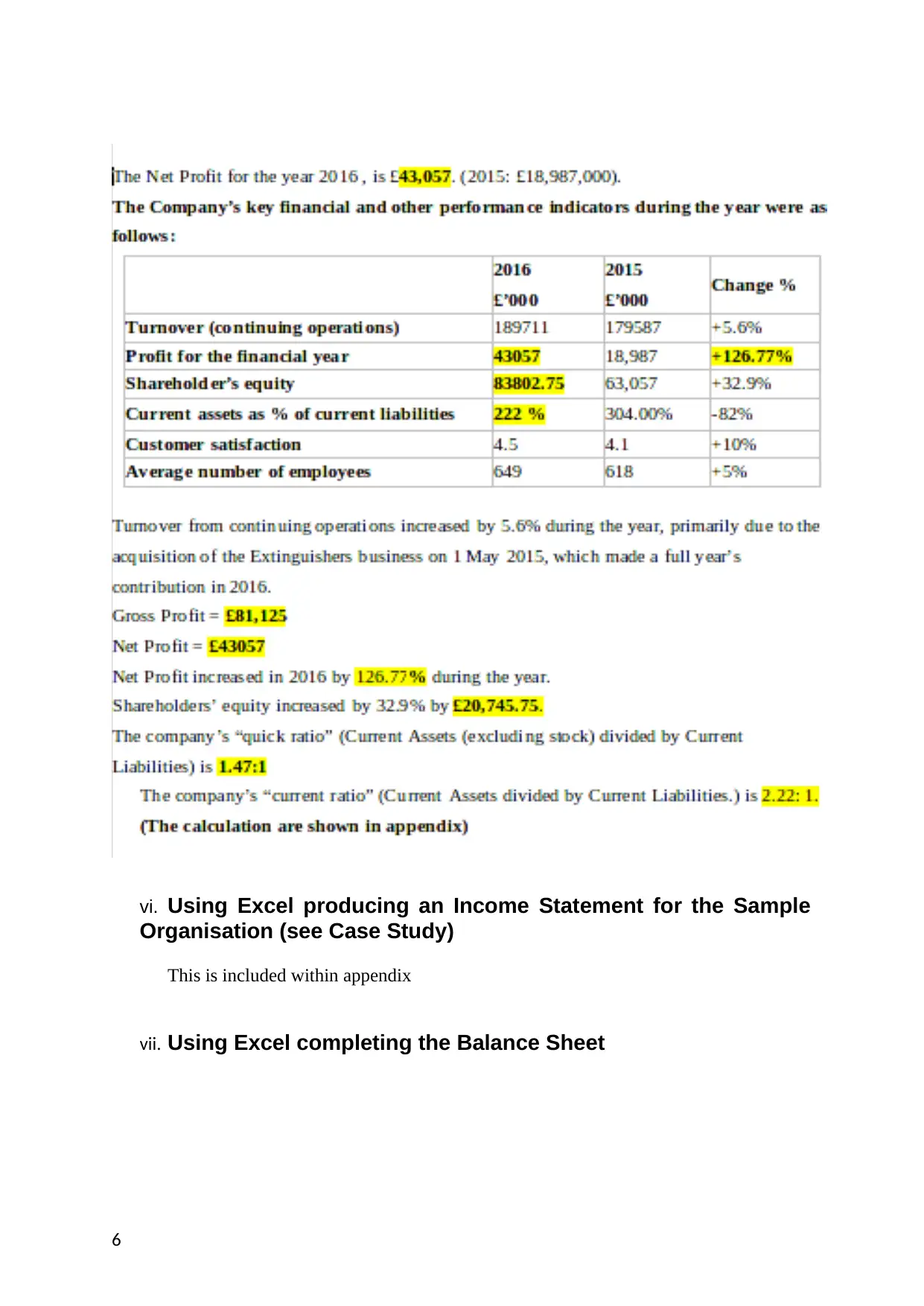
vi. Using Excel producing an Income Statement for the Sample
Organisation (see Case Study)
This is included within appendix
vii. Using Excel completing the Balance Sheet
6
Organisation (see Case Study)
This is included within appendix
vii. Using Excel completing the Balance Sheet
6
⊘ This is a preview!⊘
Do you want full access?
Subscribe today to unlock all pages.

Trusted by 1+ million students worldwide
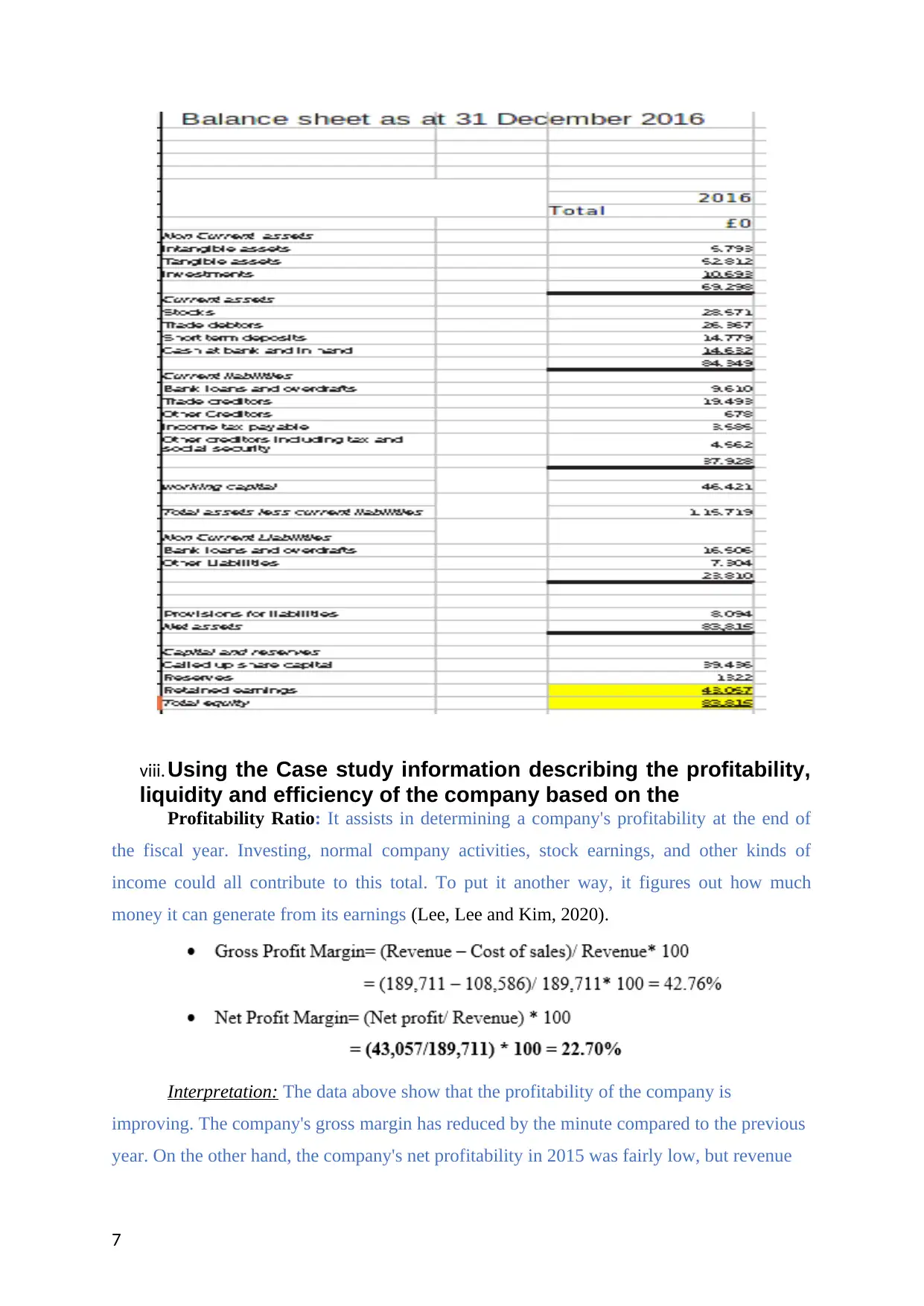
viii. Using the Case study information describing the profitability,
liquidity and efficiency of the company based on the
Profitability Ratio: It assists in determining a company's profitability at the end of
the fiscal year. Investing, normal company activities, stock earnings, and other kinds of
income could all contribute to this total. To put it another way, it figures out how much
money it can generate from its earnings (Lee, Lee and Kim, 2020).
Interpretation: The data above show that the profitability of the company is
improving. The company's gross margin has reduced by the minute compared to the previous
year. On the other hand, the company's net profitability in 2015 was fairly low, but revenue
7
liquidity and efficiency of the company based on the
Profitability Ratio: It assists in determining a company's profitability at the end of
the fiscal year. Investing, normal company activities, stock earnings, and other kinds of
income could all contribute to this total. To put it another way, it figures out how much
money it can generate from its earnings (Lee, Lee and Kim, 2020).
Interpretation: The data above show that the profitability of the company is
improving. The company's gross margin has reduced by the minute compared to the previous
year. On the other hand, the company's net profitability in 2015 was fairly low, but revenue
7
Paraphrase This Document
Need a fresh take? Get an instant paraphrase of this document with our AI Paraphraser
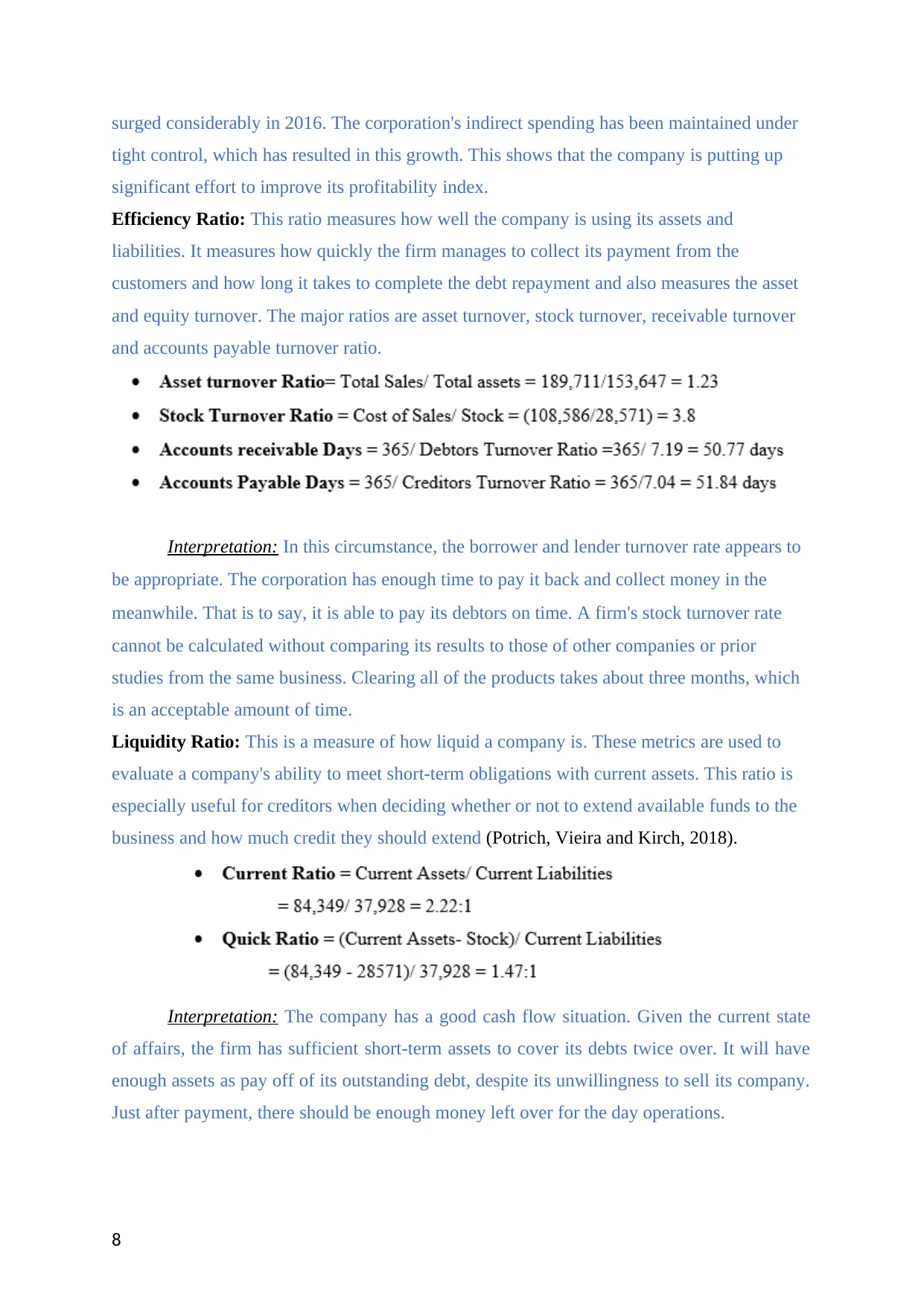
surged considerably in 2016. The corporation's indirect spending has been maintained under
tight control, which has resulted in this growth. This shows that the company is putting up
significant effort to improve its profitability index.
Efficiency Ratio: This ratio measures how well the company is using its assets and
liabilities. It measures how quickly the firm manages to collect its payment from the
customers and how long it takes to complete the debt repayment and also measures the asset
and equity turnover. The major ratios are asset turnover, stock turnover, receivable turnover
and accounts payable turnover ratio.
Interpretation: In this circumstance, the borrower and lender turnover rate appears to
be appropriate. The corporation has enough time to pay it back and collect money in the
meanwhile. That is to say, it is able to pay its debtors on time. A firm's stock turnover rate
cannot be calculated without comparing its results to those of other companies or prior
studies from the same business. Clearing all of the products takes about three months, which
is an acceptable amount of time.
Liquidity Ratio: This is a measure of how liquid a company is. These metrics are used to
evaluate a company's ability to meet short-term obligations with current assets. This ratio is
especially useful for creditors when deciding whether or not to extend available funds to the
business and how much credit they should extend (Potrich, Vieira and Kirch, 2018).
Interpretation: The company has a good cash flow situation. Given the current state
of affairs, the firm has sufficient short-term assets to cover its debts twice over. It will have
enough assets as pay off of its outstanding debt, despite its unwillingness to sell its company.
Just after payment, there should be enough money left over for the day operations.
8
tight control, which has resulted in this growth. This shows that the company is putting up
significant effort to improve its profitability index.
Efficiency Ratio: This ratio measures how well the company is using its assets and
liabilities. It measures how quickly the firm manages to collect its payment from the
customers and how long it takes to complete the debt repayment and also measures the asset
and equity turnover. The major ratios are asset turnover, stock turnover, receivable turnover
and accounts payable turnover ratio.
Interpretation: In this circumstance, the borrower and lender turnover rate appears to
be appropriate. The corporation has enough time to pay it back and collect money in the
meanwhile. That is to say, it is able to pay its debtors on time. A firm's stock turnover rate
cannot be calculated without comparing its results to those of other companies or prior
studies from the same business. Clearing all of the products takes about three months, which
is an acceptable amount of time.
Liquidity Ratio: This is a measure of how liquid a company is. These metrics are used to
evaluate a company's ability to meet short-term obligations with current assets. This ratio is
especially useful for creditors when deciding whether or not to extend available funds to the
business and how much credit they should extend (Potrich, Vieira and Kirch, 2018).
Interpretation: The company has a good cash flow situation. Given the current state
of affairs, the firm has sufficient short-term assets to cover its debts twice over. It will have
enough assets as pay off of its outstanding debt, despite its unwillingness to sell its company.
Just after payment, there should be enough money left over for the day operations.
8
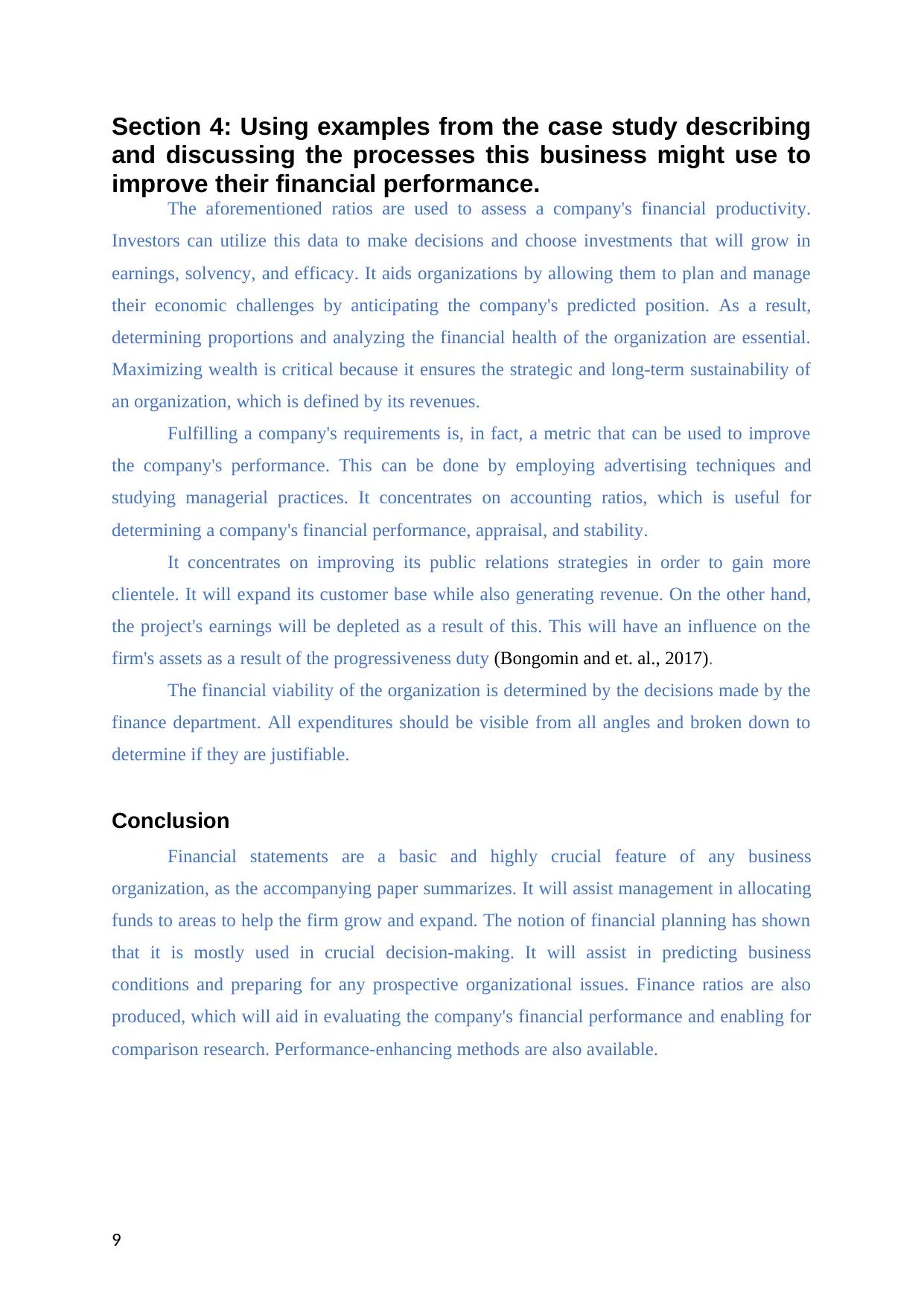
Section 4: Using examples from the case study describing
and discussing the processes this business might use to
improve their financial performance.
The aforementioned ratios are used to assess a company's financial productivity.
Investors can utilize this data to make decisions and choose investments that will grow in
earnings, solvency, and efficacy. It aids organizations by allowing them to plan and manage
their economic challenges by anticipating the company's predicted position. As a result,
determining proportions and analyzing the financial health of the organization are essential.
Maximizing wealth is critical because it ensures the strategic and long-term sustainability of
an organization, which is defined by its revenues.
Fulfilling a company's requirements is, in fact, a metric that can be used to improve
the company's performance. This can be done by employing advertising techniques and
studying managerial practices. It concentrates on accounting ratios, which is useful for
determining a company's financial performance, appraisal, and stability.
It concentrates on improving its public relations strategies in order to gain more
clientele. It will expand its customer base while also generating revenue. On the other hand,
the project's earnings will be depleted as a result of this. This will have an influence on the
firm's assets as a result of the progressiveness duty (Bongomin and et. al., 2017).
The financial viability of the organization is determined by the decisions made by the
finance department. All expenditures should be visible from all angles and broken down to
determine if they are justifiable.
Conclusion
Financial statements are a basic and highly crucial feature of any business
organization, as the accompanying paper summarizes. It will assist management in allocating
funds to areas to help the firm grow and expand. The notion of financial planning has shown
that it is mostly used in crucial decision-making. It will assist in predicting business
conditions and preparing for any prospective organizational issues. Finance ratios are also
produced, which will aid in evaluating the company's financial performance and enabling for
comparison research. Performance-enhancing methods are also available.
9
and discussing the processes this business might use to
improve their financial performance.
The aforementioned ratios are used to assess a company's financial productivity.
Investors can utilize this data to make decisions and choose investments that will grow in
earnings, solvency, and efficacy. It aids organizations by allowing them to plan and manage
their economic challenges by anticipating the company's predicted position. As a result,
determining proportions and analyzing the financial health of the organization are essential.
Maximizing wealth is critical because it ensures the strategic and long-term sustainability of
an organization, which is defined by its revenues.
Fulfilling a company's requirements is, in fact, a metric that can be used to improve
the company's performance. This can be done by employing advertising techniques and
studying managerial practices. It concentrates on accounting ratios, which is useful for
determining a company's financial performance, appraisal, and stability.
It concentrates on improving its public relations strategies in order to gain more
clientele. It will expand its customer base while also generating revenue. On the other hand,
the project's earnings will be depleted as a result of this. This will have an influence on the
firm's assets as a result of the progressiveness duty (Bongomin and et. al., 2017).
The financial viability of the organization is determined by the decisions made by the
finance department. All expenditures should be visible from all angles and broken down to
determine if they are justifiable.
Conclusion
Financial statements are a basic and highly crucial feature of any business
organization, as the accompanying paper summarizes. It will assist management in allocating
funds to areas to help the firm grow and expand. The notion of financial planning has shown
that it is mostly used in crucial decision-making. It will assist in predicting business
conditions and preparing for any prospective organizational issues. Finance ratios are also
produced, which will aid in evaluating the company's financial performance and enabling for
comparison research. Performance-enhancing methods are also available.
9
⊘ This is a preview!⊘
Do you want full access?
Subscribe today to unlock all pages.

Trusted by 1+ million students worldwide
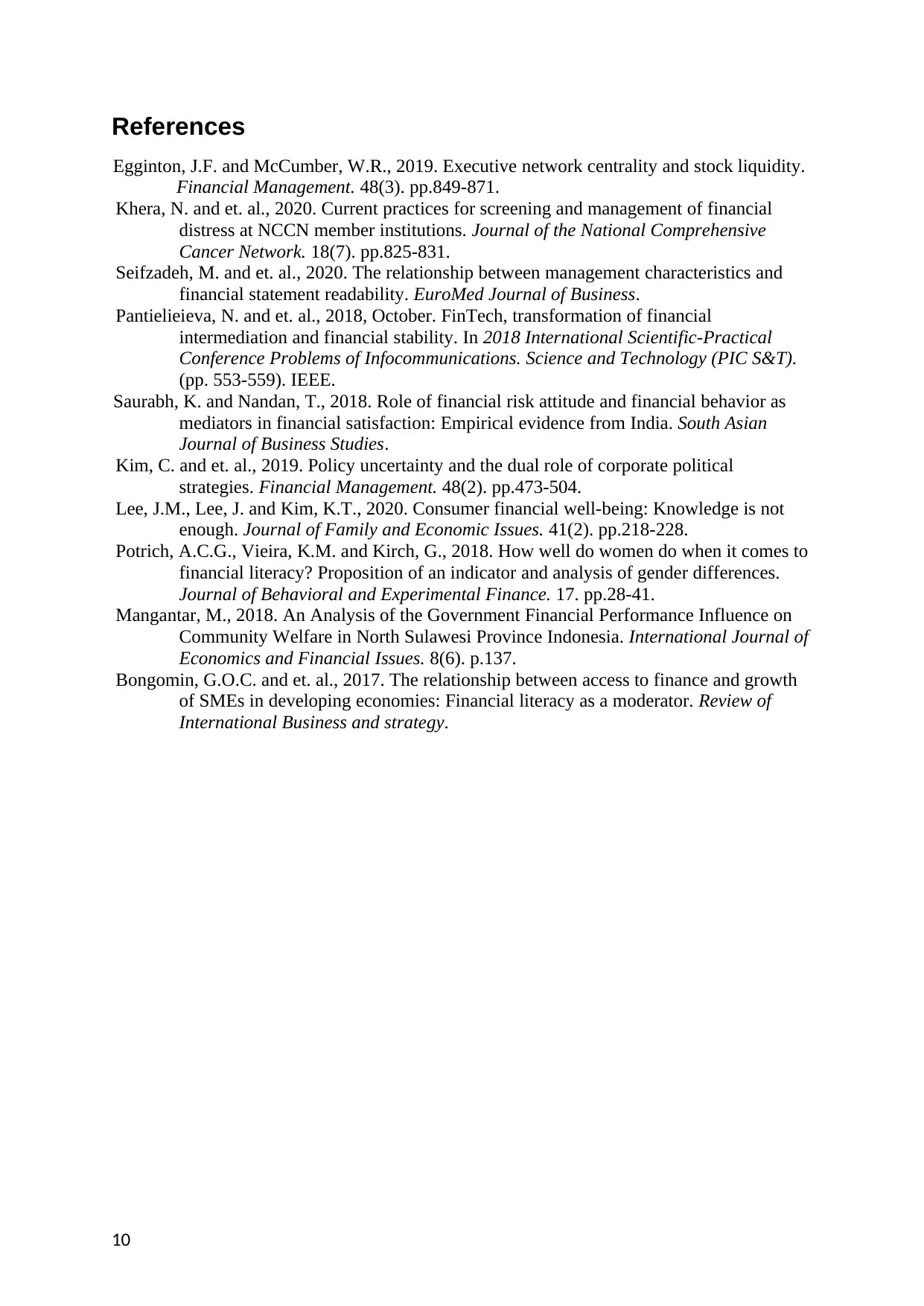
References
Egginton, J.F. and McCumber, W.R., 2019. Executive network centrality and stock liquidity.
Financial Management. 48(3). pp.849-871.
Khera, N. and et. al., 2020. Current practices for screening and management of financial
distress at NCCN member institutions. Journal of the National Comprehensive
Cancer Network. 18(7). pp.825-831.
Seifzadeh, M. and et. al., 2020. The relationship between management characteristics and
financial statement readability. EuroMed Journal of Business.
Pantielieieva, N. and et. al., 2018, October. FinTech, transformation of financial
intermediation and financial stability. In 2018 International Scientific-Practical
Conference Problems of Infocommunications. Science and Technology (PIC S&T).
(pp. 553-559). IEEE.
Saurabh, K. and Nandan, T., 2018. Role of financial risk attitude and financial behavior as
mediators in financial satisfaction: Empirical evidence from India. South Asian
Journal of Business Studies.
Kim, C. and et. al., 2019. Policy uncertainty and the dual role of corporate political
strategies. Financial Management. 48(2). pp.473-504.
Lee, J.M., Lee, J. and Kim, K.T., 2020. Consumer financial well-being: Knowledge is not
enough. Journal of Family and Economic Issues. 41(2). pp.218-228.
Potrich, A.C.G., Vieira, K.M. and Kirch, G., 2018. How well do women do when it comes to
financial literacy? Proposition of an indicator and analysis of gender differences.
Journal of Behavioral and Experimental Finance. 17. pp.28-41.
Mangantar, M., 2018. An Analysis of the Government Financial Performance Influence on
Community Welfare in North Sulawesi Province Indonesia. International Journal of
Economics and Financial Issues. 8(6). p.137.
Bongomin, G.O.C. and et. al., 2017. The relationship between access to finance and growth
of SMEs in developing economies: Financial literacy as a moderator. Review of
International Business and strategy.
10
Egginton, J.F. and McCumber, W.R., 2019. Executive network centrality and stock liquidity.
Financial Management. 48(3). pp.849-871.
Khera, N. and et. al., 2020. Current practices for screening and management of financial
distress at NCCN member institutions. Journal of the National Comprehensive
Cancer Network. 18(7). pp.825-831.
Seifzadeh, M. and et. al., 2020. The relationship between management characteristics and
financial statement readability. EuroMed Journal of Business.
Pantielieieva, N. and et. al., 2018, October. FinTech, transformation of financial
intermediation and financial stability. In 2018 International Scientific-Practical
Conference Problems of Infocommunications. Science and Technology (PIC S&T).
(pp. 553-559). IEEE.
Saurabh, K. and Nandan, T., 2018. Role of financial risk attitude and financial behavior as
mediators in financial satisfaction: Empirical evidence from India. South Asian
Journal of Business Studies.
Kim, C. and et. al., 2019. Policy uncertainty and the dual role of corporate political
strategies. Financial Management. 48(2). pp.473-504.
Lee, J.M., Lee, J. and Kim, K.T., 2020. Consumer financial well-being: Knowledge is not
enough. Journal of Family and Economic Issues. 41(2). pp.218-228.
Potrich, A.C.G., Vieira, K.M. and Kirch, G., 2018. How well do women do when it comes to
financial literacy? Proposition of an indicator and analysis of gender differences.
Journal of Behavioral and Experimental Finance. 17. pp.28-41.
Mangantar, M., 2018. An Analysis of the Government Financial Performance Influence on
Community Welfare in North Sulawesi Province Indonesia. International Journal of
Economics and Financial Issues. 8(6). p.137.
Bongomin, G.O.C. and et. al., 2017. The relationship between access to finance and growth
of SMEs in developing economies: Financial literacy as a moderator. Review of
International Business and strategy.
10
Paraphrase This Document
Need a fresh take? Get an instant paraphrase of this document with our AI Paraphraser
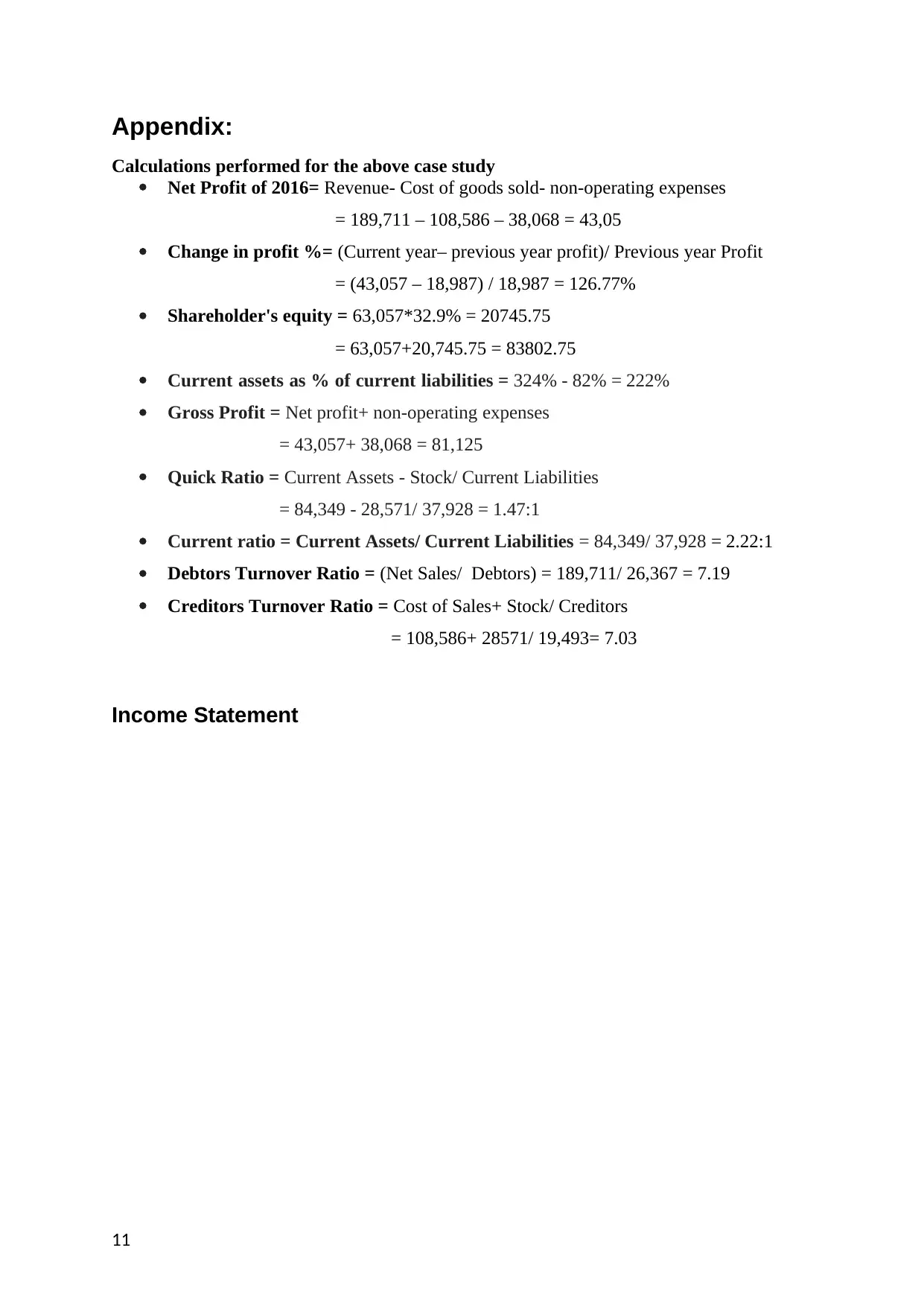
Appendix:
Calculations performed for the above case study
Net Profit of 2016= Revenue- Cost of goods sold- non-operating expenses
= 189,711 – 108,586 – 38,068 = 43,05
Change in profit %= (Current year– previous year profit)/ Previous year Profit
= (43,057 – 18,987) / 18,987 = 126.77%
Shareholder's equity = 63,057*32.9% = 20745.75
= 63,057+20,745.75 = 83802.75
Current assets as % of current liabilities = 324% - 82% = 222%
Gross Profit = Net profit+ non-operating expenses
= 43,057+ 38,068 = 81,125
Quick Ratio = Current Assets - Stock/ Current Liabilities
= 84,349 - 28,571/ 37,928 = 1.47:1
Current ratio = Current Assets/ Current Liabilities = 84,349/ 37,928 = 2.22:1
Debtors Turnover Ratio = (Net Sales/ Debtors) = 189,711/ 26,367 = 7.19
Creditors Turnover Ratio = Cost of Sales+ Stock/ Creditors
= 108,586+ 28571/ 19,493= 7.03
Income Statement
11
Calculations performed for the above case study
Net Profit of 2016= Revenue- Cost of goods sold- non-operating expenses
= 189,711 – 108,586 – 38,068 = 43,05
Change in profit %= (Current year– previous year profit)/ Previous year Profit
= (43,057 – 18,987) / 18,987 = 126.77%
Shareholder's equity = 63,057*32.9% = 20745.75
= 63,057+20,745.75 = 83802.75
Current assets as % of current liabilities = 324% - 82% = 222%
Gross Profit = Net profit+ non-operating expenses
= 43,057+ 38,068 = 81,125
Quick Ratio = Current Assets - Stock/ Current Liabilities
= 84,349 - 28,571/ 37,928 = 1.47:1
Current ratio = Current Assets/ Current Liabilities = 84,349/ 37,928 = 2.22:1
Debtors Turnover Ratio = (Net Sales/ Debtors) = 189,711/ 26,367 = 7.19
Creditors Turnover Ratio = Cost of Sales+ Stock/ Creditors
= 108,586+ 28571/ 19,493= 7.03
Income Statement
11

12
⊘ This is a preview!⊘
Do you want full access?
Subscribe today to unlock all pages.

Trusted by 1+ million students worldwide
1 out of 12